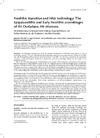Identificador persistente para citar o vincular este elemento:
https://accedacris.ulpgc.es/handle/10553/45693
| Título: | Neolithic transition and lithic technology: The Epipalaeolithic and Early Neolithic assemblages of Ifri Oudadane, NE-Morocco | Otros títulos: | Neolithisierung und Steingeräteherstellung: Epipaläolithikum und Frühneolithikum der Ifri Oudadane, Nordost-Marokko. | Autores/as: | Linstädter, Jörg Wagner, Gregor Broich, Manuel Bao, Juan Gibaja Rodríguez Rodríguez, Amelia Del Carmen |
Clasificación UNESCO: | 550405 Prehistoria 550501 Arqueología |
Palabras clave: | Neolithic transition Lithic industry Raw material Subsistenz Gebrauchsspuren, et al. |
Fecha de publicación: | 2015 | Publicación seriada: | Quartar | Resumen: | Ifri Oudadane represents one of the few recently excavated sites in NW-Africa which permits a study of the Neolithic transition. The site is dated by 23 radiocarbon ages suggesting an occupation between 11.0 and 5.7 ka calBP. The well-documented Neolithic transition occurred at about 7.6 ka calBP. This transition is marked by the appearance of pottery, cereals and legumes. Furthermore, geochemistry and micromorphology indicate several changes in the sedimentation milieu. One of the most interesting aspects of Neolithisation is the question of the continuity or discontinuity of this process. Does the transition to food production appear as part of a migration process or did local forager groups promote this develop-ment? Lithic material offers, as it appears through all periods, the best opportunity to study these developments. This paper presents an unchanging lithic industry across the Neolithisation regarding blank production, raw material supply, as well as tool composition. These results indicate an active role of local hunter-gatherers, and has therefore significant impact on the understanding of the Neolithisation process within the Western Mediterranean as a whole. Die im östlichen Rif in Marokko gelegene Fundstelle Ifri Oudadane ist eine der wenigen in letzter Zeit ausgegrabenen Fundstellen in Nordwest-Afrika, die es erlauben den Übergang vom Epipaläolithikum zum Neolithikum zu untersuchen. Die 23 14C-Daten belegen eine Nutzung des Abris im Zeitraum von 11,0 bis 5,7 ka calBP. Der sehr gut dokumentierte Übergang zum Neolithikum konnte in den Zeitraum um 7,6 ka calBP datiert werden und ist gekennzeichnet durch das Aufkommen von Keramik, Getreide und Hülsenfrüchten. Ferner belegen geochemische und mikromorphologische Untersuchungen einige Änderungen in der Sedimentation. Eine der interessantesten Aspekte der Neolithisierung ist die Frage nach Kontinuität oder Diskontinuität und damit ob der Übergang zur produzierenden Wirtschaftsweise in der Hauptsache durch Migration oder Akkulturation voran getrieben wurde. Die lithischen Artefakte bieten hierbei die einzigartige Möglichkeit kontinuierliche Entwicklungen am Übergang vom Epipaläolithikum zum Neolithikum zu entdecken, da sie in beiden Perioden auftreten. Die vorliegende Untersuchung belegt, dass sich die Steingeräteherstellung in Hinblick auf Grundformproduktion, Rohmaterialversorgung und den genutzten Werkzeugen während der Neolithisierung nicht veränderte. Dies deutet auf eine aktive Rolle der lokalen Jäger-Sammler-Gesellschaften in diesem Prozess hin und ist daher von außerordentlicher Bedeutung für das Verständnis der Neolithisierung im westlichen Mittelmeer. |
URI: | https://accedacris.ulpgc.es/handle/10553/45693 | ISSN: | 0375-7471 | DOI: | 10.7485/QU62_7 | Fuente: | Quartar [ISSN 0375-7471], v. 62, p. 155-184 | Derechos: | by-nc-nd |
| Colección: | Artículos |
Citas SCOPUSTM
15
actualizado el 08-jun-2025
Visitas
79
actualizado el 04-may-2024
Descargas
150
actualizado el 04-may-2024
Google ScholarTM
Verifica
Altmetric
Comparte
Exporta metadatos
Los elementos en ULPGC accedaCRIS están protegidos por derechos de autor con todos los derechos reservados, a menos que se indique lo contrario.
